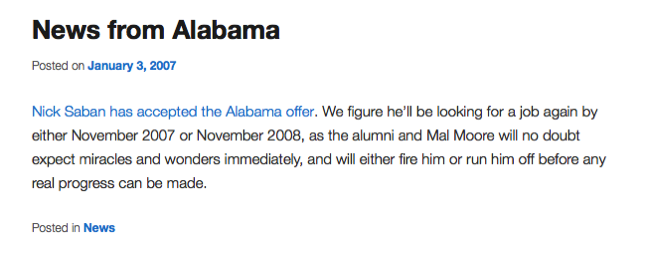Here is an elk calf, playing in a puddle. Enjoy.
This would’ve been useful information 4 years ago, let me tell ya
Lifehacker: You’re Probably not Allergic to Penicillin After All
I went through most of my life thinking I was allergic to penicillin. I’d had hives with a dose of the stuff as a child, and an also-allergic family member taught me to look for an allergy section on every medical form I filled out, and make sure to write “penicillin” on the line.
But the reason I’m telling you this story is that it turns out I’m not allergic to it after all. About 10 percent of us have a penicillin allergy on our charts, but less than 1 percent of us have a legit allergy to go with it. And if you can take that fake allergy off your chart, you’ll likely have an easier and cheaper time in all your future dealings with the medical system.
I have my own tale about this, which longtime readers of Heathen know: Four years ago this November, I was in a pretty ugly bike crash and broke my hip. One of my surgical sites contracted a postop infection. It was NOT the very-scary MRSA; it was just garden variety staph, which is usually quashed with a cycle of garden variety penicillin.
Except I’ve lived my life believing I was allergic to it, which I dutifully explained. Well, sucks to be ME, because when you have a postop staph situation and can’t take penicillin, the next option is something called vancomycin — which cannot be taken orally. I had to get a PICC line and take it intravenously.
Three times a day, for about 90 minutes at a crack.
For seven weeks.
My mother, who was a physical therapist in her working life, had been following my medical misadventure very closely. When we got to this point, she commented, offhand, “well, you know, we’re not actually sure if you’re allergic to it or not. It’s just that your father was, and so we just assumed you were.”
DAMMIT.
The Twilight of Johnny Depp
This is one insanely depressing story. Perhaps the money quote is paragraph from late in the story:
I want to go home, but feel reluctant to leave. One of the most famous actors in the world is now smoking dope with a writer and his lawyer while his cook makes dinner and his bodyguards watch television. There is no one around him who isn’t getting paid.
Emphasis added.
Your periodic reminder that the TSA is the worst
Well, when I say “worst,” obviously I’m excluding ICE, which are the literal worst. BUT:
The TSA has an internal list of people it just doesn’t like, and you may be denied boarding based on it.
Obviously, there’s no way to review this list or get off it.
This can’t be real, can it?
Bourdain on Kissenger:
Once you’ve been to Cambodia, you’ll never stop wanting to beat Henry Kissinger to death with your bare hands. You will never again be able to open a newspaper and read about that treacherous, prevaricating, murderous scumbag, sitting down for a nice chat with Charlie Rose, or attending some black-tie affair for a new glossy magazine without choking. Witness what Henry did in Cambodia – the fruits of his genius for statesmanship – and you will never understand why he’s not sitting in the dock at The Hague next to Milosevic. While Henry continues to nibble nori rolls and remaki at A-list parties, Cambodia, the neutral nation he secretly and illegally bombed, invaded, undermined, and then threw to the dogs, is still trying to raise itself up on its one remaining leg.
And now Tony is gone, and the unrepentant Kissinger still draws breath.
Your weekend reading: SPACE DADS FOR AMERICA
Sarah Gailey absolutely shreds Armageddon in this hilarious piece over at Tor.com. Please enjoy.
A sample:
Armageddon is a film composed of two neatly dovetailed love letters to toxic patriarchs. Neither can be called the primary narrative, any more than one of the four cold-opens of the picture can be called a ‘beginning.’ Grace Stamper (Liv Tyler) learns to appreciate her abusive father, Harry (Bruce Willis); her story unfurls in unwavering parallel to the story of the American military industrial complex saving the whole world. Well, the whole world except for Paris. Sorry, Paris.
Armageddon desperately wants the viewer to see Harry Stamper as the hero of the story, because in this parable of international diplomacy, Harry Stamper embodies America. All he wants to do is drill for oil, isolate his daughter from any support networks outside of the ones over which he has direct control, and kill any man who tries to form a meaningful peer relationship with her. In the scene which introduces the dynamic between Grace and her father—a scene in which he repeatedly fires a shotgun at her boyfriend, A.J. (Ben Affleck)—Harry asserts that he has repeatedly asked Grace to call him “Dad.” The camera lingers on his soulful eyes, and the viewer is reminded that he is Sympathetic. He wants what’s best for his daughter, the camera explains. It just happens that what’s best for her is the complete sublimation of her personal agency. Is that so much to ask?
And also:
The asteroid threat justifies the existence of the American Military Industrial Complex the way nothing else ever could. “Thank goodness we have nuclear bombs,” shouts Michael Bay over the half-eaten remains of a Thanksgiving dinner you wish you had found an excuse to miss, “because what if there was an asteroid?!”
Seriously. Go read this.
Dept. of Write What You Know, Afghani Edition
(This is also something that’s been buried in my inbox.)
Predator & similar drones are now showing up in traditional Afghan rugs.

Dept. of Early 21st Century Comedy Bits That Would Not, At This Point, Play Well
14 years ago, promoting Anchorman, Will Ferrell visited Conan back when Conan was on Late Night, and really kind of before DVRs took over. Few watched or recorded; it was weird and chaotic and almost devoid of rules.
So they did this. It’s long. Stay with it. Make time, but if you absolutely cannot wait, skip ahead to 9:40, and realize that this joke only comes after Ferrell has been playing it straight on the couch for nearly ten minutes.
Dept. of Flickr Archeology
So for reasons known but to God, some Internet rando just favorited a picture in my Flickr stream from 2007. It’s from a then-current meme about what we carry in our pockets. Click thru, because the picture is annotated, but here’s a smaller version:
I’m amused at what’s changed, and also at what’s the same.
- I still carry a Swiss Army Knife, but it’s a smaller model, since I never have to take computers apart anymore.
- I still carry that coupon.
- After years off the road, I quit carrying a Bluetooth headset — until this year, when I bought some Airpods, which are kind of crap for real listening but GREAT for phone conversations and online meetings. What interesting is that the Plantronics in the picture also did the “case is also a charger” thing that the Airpods do, if I remember correctly.
- Same ring. The annotation on the ring notes our “days married” count at the time, which was 662. It’s now 1,293.
- There’s always a book.
- The current flashlight is MUCH SMALLER, much brighter, and much cheaper.
- I never carry a USB drive anymore, probably because online storage is more viable with better bandwidth, and also because our phones are so much better.
- Same money clip. Different money, though.
- I still HAVE that watch, but for the last 2 years I’ve been wearing an Apple Watch pretty much exclusively. I got a series 1 watch in the spring of 2016, to support training for a half marathon I was doing that fall, and the overall utility was so great I wore it pretty much all the time. When the S3 was introduced last year, with real waterproofing and on-board cell, I upgraded.
- Yup, still notebook nerd, and I still use a Vanishing Point, though several years ago my brother gave me a nicer iteration of that pen.
- I never leave the house, so keys are in the hallway.
- No more contacts. I stopped being able to tolerate them several years ago; oh well.
- It’s more about Burt’s Bees now than Carmex, but life goes on.
- That Microsoft/HTC phone lasted like 6 months. Pretty soon, I was too frustrated with how unremittingly DUMB it was about so, so many things. For one thing, you needed a 3rd party mail client for IMAP, which is hilariously stupid. For another, it would do astoundingly silly things like continue to refresh web pages with the display off, so if you were reading CNN and put it back in your pocket, odds are the phone would be dead when you tried to use it later. I replaced it with a first-gen iPhone, and I’ve been on iOS ever since (OG -> 3GS -> 4 -> 5 -> 6 -> 6S -> 8).
- The wallet finally gave up the ghost; current version is a Saddleback I’ve had for many years now.
“People say nothing is impossible, but I do nothing every day.”
Ewan McGregor is all-grown-up Christopher Robin in the upcoming film of the same name.
It looks to be a very by the numbers take on the “grown up revisits childhood to remember what’s important” trope, and yet shut up and take my money. Seriously.
Hayley Atwell is his wife. In theaters August 6.
What, you DON’T have a favorite art heist?
Erin and I do, for SURE: it’s the Isabella Stewart Gardner Heist, which remains UNSOLVED.
BoingBoing is featuring a podcast on it this week that may be worth your time.
Over at the OA: “Mississippi, murder, and William Eggleston’s ‘Red Ceiling'”
It begins:
William Eggleston first tried peyote one summer in the early 1960s while visiting a friend in Oxford, Mississippi. You can find the story in a memoir by University of Mississippi football star (and later Dark Shadows actor) Jimmy Hall, who was there at the time. Eggleston had invited Hall to join him and his friend, and the three men puzzled over the green-blue cactus in its cardboard box, purchased via mail-order from a nursery in Laredo, Texas.
And later:
The house in the photograph belonged to a man named Tom “T. C.” Boring, a dentist born and raised in Greenwood, whom Eggleston has described as the best friend he ever had in the world. He was the scion of a well-respected Delta family, a sharp and promising Southern archetype who glided his way through the University of Mississippi, Loyola University, and the Navy before coming home to Greenwood and gradually, ungracefully losing his mind.
[…]Boring had a penchant for exotic plants, younger women, and corn whiskey. In public, he often wore tweed suits and turtleneck sweaters, and smoked a pipe. But more often than not, he wore as little as possible; at home, he preferred to avoid clothes altogether. At the height of summer, he’d keep his air-conditioner cranked up to full blast so he could always have a fire going in his living room, for ambiance.
He slept odd hours. He made cryptic jokes. He owned a number of iguanas. His prized possession was his pet capybara, which he’d walk around the neighborhood on a leash.
Keep the South weird.
(Astute readers will of course note that the photo mentioned in the title is also the album cover for Big Star’s Radio City, though the edition you probably own is a combo CD with #1 Record that has a different cover.)
“It’s a great reminder that we should look up more often.”
Wylie Overstreet took his telescope out to the streets of LA, and showed people the moon.
Make time.
This week in Texas
So, this story is already bananas, right?
“Drunken Texas mom is booted from school play, kicks officer and floods jail, police say“
It’s crazy even before you get to this:
Officers reported finding eight 75-mL vodka bottles — seven of them empty — in her purse.
7 x 75ml is 525ml, or more than 2/3 of a fifth.
BUT IT GETS MORE NUTS, because these are the links at the bottom for “related stories”:

Solid advice, Margot.
“Hey, Will Smith! How’d you get on Fresh Prince?”
Good lord, absolutely MAKE TIME TO WATCH THIS, because it’s awesome.
Today in Thai Food
Every wonder why there are so many Thai restaurants? Given the proportion of Thai folks in the US, they punch WAY over their weight class in terms of ubiquity of cuisine (which is awesome), but how did that happen?
Turns out, there’s a thing called “gastrodipolmacy:”
Using a tactic now known as gastrodiplomacy or culinary diplomacy, the government of Thailand has intentionally bolstered the presence of Thai cuisine outside of Thailand to increase its export and tourism revenues, as well as its prominence on the cultural and diplomatic stages. In 2001, the Thai government established the Global Thai Restaurant Company, Ltd., in an effort to establish at least 3,000 Thai restaurants worldwide. At the time, Thai deputy commerce minister Goanpot Asvinvichit told the Wall Street Journal that the government hoped the chain would be “like the McDonald’s of Thai food.” Apparently, the government had been training chefs at its culinary training facilities to send abroad for the previous decade, but this project formalized and enhanced these efforts significantly.
The McDonald’s of Thai food never quite materialized as a government-operated megachain, but the broader goal of a government-supported increase in the number of Thai restaurants abroad has. The Thai government has continued earmarking funds for the global proliferation of galangal root and fish sauce, and it’s paid off.
The strategies for achieving this increase were manifold, run in parallel by various departments of the government. The Ministry of Commerce’s Department of Export Promotion, most likely run by bureaucrats rather than restaurateurs, drew up prototypes for three different “master restaurants,” which investors could choose as a sort of prefabricated restaurant plan, from aesthetic to menu offerings. Elephant Jump would be the fast casual option, at $5 to $15 per person; Cool Basil would be the mid-priced option at $15 to $25 a head; and the Golden Leaf prototype would cost diners $25 to $30, with décor featuring “authentic Thai fabrics and objets d’art.” (Does your favorite Thai spot have objets d’art? The restaurant may have been built from a government prototype.)
This is brilliant and awesome.
Hey Chet, what’s a Criterium?
Scary as FUCK, that’s what.
Seriously, though, it’s a timed, multilap bicycle race over a relatively short closed course. We had one here in Houston on Sunday morning, and while I don’t participate, I have a lot of friends who do.
It’s not one big race, obviously. Bike racing, like most sports, is split into levels. Let’s be clear, too: Cat 5 riders are CRAZY strong compared to non-racing folks. I’ve been doing pretty serious structured workouts for 6+ months now, and I’m absolutely sure that I’d still be dead last in any competitive Cat 5 field.
- Rank beginners are Cat 5.
- Some of those will progress to Cat 4.
- Getting to Cat 3 involves a shitload of work and no small amount of talent. I don’t know many Cat 3 road racers.
- By the time you’re in Cat 2 or Cat 1, you’re getting lots of stuff for free.
- Above Cat 1 you find the Pro ranks — and it’s a long way from being a local pro to the class of folks you’ll see on the Champs-Élysées every summer.
And for logistics purposes, these categories combined for actual races. For example, we had friends in 4 different races on Sunday morning:
- 1 in the Men’s Cat 4/5 race;
- 4 in the combined Women’s Cat 4/5 & Women’s 40+ 3/4/5 race;
- Several in Men’s Masters 4/5 (35+);
- Plus my coach Jason in the Men’s Cat 3
Jason was doing well going into the final lap, but in close-quarters riding like this crashes are a risk, and they had one. Jason didn’t go down, but he was behind it enough that it blew his finish.
Someone very close to Jason in the peloton had Garmin cameras on the front and back of his bike, and has posted the final lap. You don’t really see Jason until the post-crash moments, when he edits in the rear-facing footage, but when you do it’s super clear how close he came to being in a super scary sprinting pileup.
He’s here (click to embiggen; note they’re at 25MPH here!):
And here’s the whole video:
Stay with the video until the finish, and pay attention to the lower left; the camera setup used by the rider allows him to superimpose his speed and power on the screen. Yes, they’re sprinting at 40MPH.
For more fun footage, check out this guy’s 7:30 video, which includes some sweet overhead drone footage.
In just two states, a majority of those polled still oppose marriage equality. Guess which two.
If your guess was the (not so) charming shithole of my birth and its only slightly more modern doppelganger to the east, you win the prize.
Very, very big snuggles
It’s my birthday. Let’s talk about MS.
In 46 days, I’ll ride my bike to Austin again. I’m in shape for it, and I feel good, but the real challenge this year is getting my fundraising to a new highwater mark.
Yeah, I said it. High. Water. My guess is that this year, on account of Harvey, the fundraising pace is going to be off. This isn’t just a number; less money donated means fewer resources for the National MS Society, and that translates to less help for researchers, less support for those living with MS, and — frankly — less good in the world.
Let’s do what we can to make it a good year. Here’s my link; I’m pretty sure you know how this works.
And now, as a reward, I give you TEN REASONS TO DONATE TODAY BESIDES IT BEING MY BIRTHDAY:
10. On this day in 1781, William Herschel discovered Uranus. The jokes write themselves.
9. Microsoft went public on this day in 1986. Had you purchased the stock on the day of issue, you’d be able to donate much, much more!
8. What better way for the Catholics among you to honor the elevation of Jorge Mario Bergoglio back in 2013?
7. Not to be outdone by Herschel, Clyde Tombaugh discovered Pluto on this day in 1930. (Shut up. It is TOO a planet.)
6. Ten years before I was born, the world gained US bassist Adam Clayton. There’s a joke here about still-not-having-found-what-I’m-looking-for, i.e. a donation, but let’s just ignore it, okay?
5. Perhaps you could spare a wad(d) of cash today in honor of the 30th anniversary of the passing of John Curtis Holmes?
4. Don’t forget! It’s National Elephant Day in Thailand! (I know nothing about this, but how can something called National Elephant Day be anything other than awesome?)
3. If you’re nerdy, perhaps you can donate partially in honor of VMS and WinNT designer Dave Cutler, who turns 76 today.
2. You like rear-engine cars? So do I! Drop a bit of coin in my fundraiser here in honor of The Love Bug, which opened on this day in 1969.
1. Block that Thetan! It’ll help make you Clear, since this is also L. Ron Hubbard’s birthday.
Why the AR-15 is different, and what that means
So, this is where your favorite gun-savvy lefty explains some things.
Lately, we’ve heard a LOT about the AR-15, which is the civilian and semi-automatic version of the M-4 used by our military. The rifle is ubiquitous today; until recently, I’d bet 90% of America was within 20 miles of a store that would sell them one this afternoon. They’re not that expensive, and they’re absolutely terrifying — it’s not for nothing that they’re the weapon of choice for mass shootings.
The the AR-15 is really just one of a class of magazine-fed, semi-automatic rifles chambered for a particular bullet type (the proper term is “round” or “caliber”) usually abbreviated to “5.56”. The proper name is 5.56 x 45mm NATO.
It’s not an especially beefy or powerful round in the realm of rifle rounds; most folks hunt deer with far larger calibers. It’s relatively small size, though, makes it very, very well suited for rapid fire because it produces so little recoil (“kick”). Sure, you almost never see a fully-automatic AR used for crimes, but it hardly matters because a semi-automatic version will fire as quickly as you can move your finger.
That small round packs a tremendous punch — especially since it’s usually shot from a platform that allows or even encourages the shooter to keep firing.
So in this context, take a look at this piece by a Parkland area radiologist, speaking about the wounds from the MSD shooting:
What I Saw Treating the Victims From Parkland Should Change the Debate on Guns.
This is from a radiologist with plenty of exposure to handgun wounds. They tend to be relatively simple and manageable, and if the bullet manages to avoid something critical like the aorta or the heart, the patients tend to survive:
In a typical handgun injury, which I diagnose almost daily, a bullet leaves a laceration through an organ such as the liver. To a radiologist, it appears as a linear, thin, gray bullet track through the organ. There may be bleeding and some bullet fragments.
I was looking at a CT scan of one of the mass-shooting victims from Marjory Stoneman Douglas High School, who had been brought to the trauma center during my call shift. The organ looked like an overripe melon smashed by a sledgehammer, and was bleeding extensively. How could a gunshot wound have caused this much damage?
More:
Routine handgun injuries leave entry and exit wounds and linear tracks through the victim’s body that are roughly the size of the bullet. If the bullet does not directly hit something crucial like the heart or the aorta, and the victim does not bleed to death before being transported to our care at the trauma center, chances are that we can save him. The bullets fired by an AR-15 are different: They travel at a higher velocity and are far more lethal than routine bullets fired from a handgun. The damage they cause is a function of the energy they impart as they pass through the body. A typical AR-15 bullet leaves the barrel traveling almost three times faster than—and imparting more than three times the energy of—a typical 9mm bullet from a handgun. An AR-15 rifle outfitted with a magazine with 50 rounds allows many more lethal bullets to be delivered quickly without reloading.
I have seen a handful of AR-15 injuries in my career. Years ago I saw one from a man shot in the back by a swat team. The injury along the path of the bullet from an AR-15 is vastly different from a low-velocity handgun injury. The bullet from an AR-15 passes through the body like a cigarette boat traveling at maximum speed through a tiny canal. The tissue next to the bullet is elastic—moving away from the bullet like waves of water displaced by the boat—and then returns and settles back. This process is called cavitation; it leaves the displaced tissue damaged or killed. The high-velocity bullet causes a swath of tissue damage that extends several inches from its path. It does not have to actually hit an artery to damage it and cause catastrophic bleeding. Exit wounds can be the size of an orange.
Let’s quantify this. Wikipedia can help; let’s compare the 5.56 to the most popular handgun round, 9mm.
Firearm ballistics are a complicated area that people LOVE to argue about, but the gist of the system boils down to the bullet’s mass and the amount of energy pushing it forward. The bullets are measured in grams (or sometimes another unit called grains); we talk about energy in terms of muzzle velocity and downrange energy. The difference, as the author notes, isn’t small:
- A 5.56mm round involves a fairly tiny bullet (~ 3-4 grams, so more than a penny and less than a nickel) moving at about 900 m/s, and will deliver on the order of 1,800 joules downrange.
- The 9mm pistol users a heavier bullet (7 to 8 grams, so twice as massive as the 5.56), but it’s moving far slower: usually the neighborhood of 350 or so m/s, so the energy delivered when it his something is also far lower (~ 500 joules).
An AR-15 is also engineered to shoot quickly, and shield the user from almost all the recoil. I’ve shot one several times; it’s very easy to shoot, and very easy to shoot quickly without losing the target. Frankly, it’s easier to stay on target with an AR than it is with most 9mm pistols.
This is why the wounds the Parkland physician saw were so much worse, and why mass shootings end with so many dead: because it’s easy to get a weapon that will fire very many of these very lethal rounds very quickly. And the NRA likes it this way.
Oh, one more thing: Gun violence is clearly a public health problem in the United States, but we don’t study it. Why?
The Centers for Disease Control and Prevention is the appropriate agency to review the potential impact of banning AR-15-style rifles and high-capacity magazines on the incidence of mass shootings. The agency was effectively barred from studying gun violence as a public-health issue in 1996, by a statutory provision known as the Dickey Amendment.
Why is it banned? Because the NRA doesn’t want it studied. Think on that.
Just one of SEVERAL reasons why diving in Minnesota is a bad idea
Someone put a chained-up statue of Jason Voorhees in the bottom of a Minnesota lake, just to mess with divers.
Barnes & Noble Exec Management Is Apparently 100% Shitweasel
Go read “The Entirely Unnecessary Demise of Barnes & Nobel”. It’s astounding and, near as I can tell, completely accurate.
On Monday morning, every single Barnes & Noble location – that’s 781 stores – told their full-time employees to pack up and leave. The eliminated positions were as follows: the head cashiers (those are the people responsible for handling the money), the receiving managers (the people responsible for bringing in product and making sure it goes where it should), the digital leads (the people responsible for solving Nook problems), the newsstand leads (the people responsible for distributing the magazines), and the bargain leads (the people responsible for keeping up the massive discount sections). A few of the larger stores were able to spare their head cashiers and their receiving managers, but not many.
We’re not talking post-holiday culling of seasonal workers. This was the Red Wedding. Every person laid off was a full-time employee. These were people for whom Barnes & Noble was a career. Most of them had given 5, 10, 20 years to the company. In most cases it was their sole source of income.
There was no warning.
But it gets worse.
The people who lost their jobs had been actively assured this would NOT happen for the past several months. Home Office decided last year that these positions – head cashiers, receiving managers, leads – were due to be eliminated… but no layoffs were to take place. All current employees were to be grandfathered in. The positions wouldn’t go away until the people currently holding them chose to leave.
For months they told everyone this.
Then on Monday, each person was called into the manager’s office. Fifteen minutes later, each person gathered up their things and left.
But but but dropped sales, right? Well, about that: go read the whole piece. Barnes set this up by screwing up Christmas in an attempt to shore up the amount of cash on hand. The Barnes leadership are not trying to save the company. They’re trying to get out with giant golden parachutes, and give not two shits for their employees.
This is AWESOME.
Clever Girl(s)
I’m sure that we’re totally safe from robots, unless they figure out how to open doors.
Well, about that….
Erin does this. I’m sorry I haven’t written them all down.
Sometimes, Twitter user @Sleep_Sayings’ boyfriend says inscrutable, hilarious things in his sleep. So she started a twitter account.
Do NOT miss this
You’ve probably seen references to it, but if you haven’t actually read the Quincy Jones interview in Vulture, by all means make time NOW.
(The recent GQ profile is also fun.)
Hey, check out this FURBY ORGAN
No, seriously. SFW.
Studies in Athletic Performance
It’s no secret I ride a lot. I love it, but I found late last year that I wasn’t improving as fast as I used to. It’s not age, or not exclusively age; it’s just that, beyond a certain point, you have to do something more than “just ride a lot” — you have to get intentional about it, and that means a power meter and structured training and a coach and hours on an indoor trainer where you can watch output and hit power targets and all that jazz.
Luckily, I enjoy data, so at least that part’s fun.
Luckily, too, is the fact that this new approach is absolutely working. There’s no coasting in an hour-long workout, nor is there drafting; you’re just putting in the work. SOME of these workouts I can do on the road, or at least on the closed track at Memorial Park, but mostly it’s on a trainer in my office starting at a bookcase.
Obviously, then, podcasts and music are involved. Sometimes it’s TAL or Omnibus or something, and sometimes it’s tunes. I made a playlist I shuffle over that’s got lots of music I like; it’s heavier with hip-hop than I would’ve guessed, but once you add some RTJ and Kanye’s “Stronger,” it’s easy to stay with the theme.
Today, I was having some trouble hitting the targets — the tl;dr is that I got stronger, so the workouts just got harder — but upon review I found there was an anomalously high peak in the final period of effort, which coincided with the end of a podcast and the start of the aforementioned shuffled playlist.
I know what song was playing, so I think I’m justified in identifying this phenomenon as the “Xzibit Peak“:

“What did you think was going to happen, Steven?”
I fucking love the Skittles ads.
Explicitly for Erins
This year, Emmet Otter turned 40. It aired in Canada first, for Christmas 1977, before hitting HBO the next year, and network TV 2 years later.
Here’s a nice oral history. You probably remember it fondly from your childhood, but it’s also a tour de force of groundbreaking puppet filmmaking. No, I’m not kidding:
Though filled with old-fashioned charm, Emmet Otter actually employed a savvy blend of age-old puppetry techniques and cutting-edge animatronic technology. Engineering wizard Franz “Faz” Fazakas, a frequent Muppet collaborator, designed the rowboat that could be steered along the set’s 50-foot river, and rigged versions of Ma and Emmet that could be operated via remote control while they were on the water.
Oh, also:
The tale of Frogtown Hollow continued to hold a special place in the hearts of those involved — including Henson, who included one of Emmet Otter’s songs in the musical program he designed for his memorial service [in 1990].
Paul Williams: The last thing that I ever expected was to hear “When the River Meets the Sea” at Jim’s funeral. It was an especially emotional moment in the funeral for me
(Oh, and, don’t miss the actual no-kidding blooper reel, shot during the 33 takes it took to get the “drum rolls out of the shop” shot.)
Stapled Yellow Cards, History, and Finding Yourself On The Other Side
When I was a kid, my dad was a veterinarian. In the 1970s, there was no office computerization, so he kept his patient records on yellow cards. As each card filled, he’d add another to the top of the stack, forming a reverse-chronological record of the client’s visits.
(I’ve never seen these size cards anywhere else, but they were cleary a Thing at the time. In my memory, they were each about a third of a sheet of typing paper, but on heavier stock; he also had sturdy steel cabinets to file them in, so it was clearly a standard of some kind.)
Obviously, over time, these card stacks got thicker and thicker — some quickly, because the client had lots of animals; some more slowly, just on the strength of long-lived pets getting their annual attention for years upon years. By the early 80s, when I was working part time there, a few were over an inch thick; these belonged to the families that had sought my father out when he first hung his shingle in 1964, and still used him, many pets later, in the 1980s. Perhaps the fattest belonged to the Slay family.
When my father first opened, he sent my mother out to find an accountant about their age. People didn’t move around as much back then, so the plan was to find one they could keep forever. Mother found Herbie Slay, and as the story goes that same day Mrs. Slay brought their dog to dad for a checkup. In small towns, there’s a lot of that sort of backscratching. (Incidentally, the firm Mr. Slay founded still does my taxes every year; Herbie, sadly, passed away a year or two ago.)
The Slay file was, to my early teen eyes, an artifact from another time. Sure, the top page was from last week or last month, but there at the back were records my father wrote when Johnson was president, when men wore flattops, when Vietnam was in the news every day. Impossibly long ago, I thought. When Dad died, in 1986, I meant to save that file, or at least the first page, but in the rush and chaos and haze of funeral and clinic sale and grief, it didn’t happen, and so now it lives on only in my memory.
I’m nearly 48 now — older than Dad ever got to be — and I know better than to think of 22 years as an eon, though of course it still is.
Today, I took our cats to our veterinarian for their annual shots. They hate it, obviously, and they hate it moreso because even though the clinic is inside the Loop, there’s no good freeway option, so it can be a half hour drive on congested surface streets to get there.
Because of this, every year before now I thought “I should really find a closer vet, since it’s just shots,” and every year before now I quashed that thought out of loyalty. I started using this clinic in 1994, soon after I moved to Houston, and I am not good with change.
Back then, it was just Dr. Alice Frei and maybe one tech in a storefront in Bellaire, around the corner from my first home here, and chosen for proximity as much as anything else. Over time, she grew that clinic, and I didn’t always see Dr. Frei anymore. She’d taken partners, or hired subordinate vets, or something, but that’s what happens, and they were all nice people. At some point, she moved to a nice new building. I was happy for her growth and success, and we always got good care there. Even when our old girl Bob was so sick we had to seek out specialists, they still reached out to us for updates, and sent us a card when the end came.
It’s like that.
But this time around, when we called for our annual appointment — several months late, I must confess — I learned that Dr. Frei wasn’t there anymore, and that she’d sold the practice and moved to Virginia. “Good for her,” I thought. But also: “Well, crap.”
So we went today, and at the end I mentioned that, gosh, if it’s not Dr. Frei anymore, I’m not sure I’m going to keep driving this far, and how would I go about transferring records?
The veterinarian completely understood. Of course they’d send records over to wherever we wanted. “That makes perfect sense; most of our customers are very close, so we totally understand.” I felt awkward about it, but he was very gracious and kind.
We boxed up the cats, and I went out front to pay. As I was paying, though, the vet came back out, smiling. “You know, Mr. Farmer, we have a sequential numbering system for client records here. Each new customer gets the next number.”
Sure. That makes sense.
“The newest record in the system is 7200 something.”
Ok.
“You’re number 35.”
Wow.
I had the sense, 23 years ago, that Dr. Frei’s was a new practice, and I liked that about it. I didn’t realize how new, or how early I was on that August afternoon in 1994. Driving home, I couldn’t help but remember those fat, multi-stapled cards in Dad’s office 30 years ago, and the history they represented. But math will get you; our file at Southside Place reaches back to August of 1994, which is deeper than any file my father ever had. To my everlasting shock and bemusement, we’re the subject of a file just as ancient as the Slay file seemed to me in 1986.
Among the many surprises of middle age are these moments when you find yourself looking at some aspect of life from exactly opposite perspectives, separated by a decade or two.
Life is weird and wonderful. I wouldn’t have it any other way.
They know, you know.
Ladies and gentlemen, the future.

Sigh.
They only do this because interior decorators are frequently illiterate
There is apparently a trend among halfwit, muzzy-headed interior decorators to encourage clients to shelve books backward because “more consistently neutral color” matters more than “being able to find a book.”
It’s probably time to bring back tarring and feathering.
“And he’ll drive the thing like a cocaine fiend playing Mario Kart.”
This is old, but great: The Scariest Thing About the Hellcat is the Third Owner
A bit:
For those of you who don’t know what the Hellcat is, please allow me to provide the following background: it is a 707-horsepower rental car.
Do you know that Dodge Charger you rented a few months ago? When you landed in Dallas? And they were out of midsize sedans? And you couldn’t figure out why it smelled so bad? And the interior was made out of the same quality plastic they use for a Parmesan cheese container? Well, imagine that thing with more power than a Ferrari Enzo. That’s a Hellcat.
At the moment, they sell the Hellcat in two varieties. There is the Dodge Challenger Hellcat, which is a rather large two-door vehicle. And there is a Dodge Charger Hellcat, which is a rather large four-door vehicle. Reportedly they will soon be making a Hellcat version of the Jeep Grand Cherokee, which will serve as the primary example for at least the next decade when people in other countries discuss American excess.
Why the third owner, though? Well, he tells us:
You see, the first owner of the Hellcat is going to be a pretty careful, cautious, reasonable guy. The car’s price tag ensures that: most Hellcats cost somewhere in the $60,000-plus range, which is right in the heart of “careful, cautious, reasonable guy” territory. If you’re spending sixty grand on a car, you’ve probably been around enough attorneys in your life to know that the guy with the 707-horsepower car is the first person to get sued after an accident, even if the accident involved an industrial forklift and the 707-horsepower car was parked four blocks away. So you’re careful.
Sure. Okay. But what about #2?
The second owner is different from the first owner in the sense that he didn’t buy the Hellcat because it was the latest and greatest thing. He bought it because he lusted after it from the moment it came out – he just couldn’t afford it right away. So he buys the thing when it’s one or two years old, and he cherishes it. I mean he cherishes it. To the point where he creates one of those little plaques that he places next to his car when he brings it to cars and coffee.
And so:
The third owner will buy a Hellcat ten years from now. He will be under 30 years old. He’ll look for one with high miles, or a rebuilt title. And he’ll drive the thing like a cocaine fiend playing Mario Kart.
The problem with the Hellcat’s third owner is that he won’t be as cautious as the first owner, and he won’t be as obsessed with preservation as the second owner. He’ll just want cheap speed, and the Hellcat will provide it.
Now, if you’re the parent of a young child, this could be a serious problem when your kid grows up. Consider it: when I was 20, the fastest thing anybody could reasonably afford was a first-generation Cadillac CTS-V, which had 400 horsepower and a gear lever that felt like you were stirring butter with a rope.
But if your kid is eight or nine years old right now, he will reach 20 at a time when the seven-hundred-seven horsepower Hellcat is something his friends might be driving. As a parent, this changes your duties: you will have to educate your child about crossing the street, and talking to strangers, and finances, and sex, and friends with Hellcats.
ZING:
Think of it this way: by 2026, a high-mileage Hellcat will be a sub-$30,000 way to get 700 horsepower; a 200-mph car that no longer requires a professional degree, or an MBA, or a long, successful career, or a profitable startup. All it will require is a promotion to assistant manager of a Pizza Hut.
Ten Years Ago in Heathen
LOL:

BRB. Buying some HotWheels tracks.
This is either evil or brilliant. It may be both.
WAT THE HELL, Tove Lo edition
When I see interesting things on Twitter I don’t have time for right away, I email the tweet to myself. Generally what happens then is I forget completely about it in my inbox, since I’m a proud practitioner of Inbox 9,028.
I was just reviewing some of those, and I found a tweet from @ParkerMolloy saying “This is the weirdest music video I’ve seen in a while” with a Youtube link.
Parker is not wrong. Stay with it until AT LEAST 2:00. Longer is better. Plus, it’s catchy.
Definitely NSFW, however. Also, trigger warning for puppet sex — which, I think, is a first for Heathen. Go us.
“There is really no way to know for sure whether the physical universe also uses invisible squirrel timers.”
Heh.
One more year and they’ll draft this damn thing
This blog is 17 years old today.
Wacky.
Our Grim Meathook Future
China has drones with flamethrowers:

Things even non-riders might find amusing
I like riding, and I like data. I also like getting faster, so with the encouragement of a friend who offered to coach, I bought a power meter for my bike to facilitate more directed training.
In order for this to be useful, though, I also needed to establish a baseline of my maximum sustained effort. Cyclists call this the Functional Threshold Power. The truer test is an hour long ride where you go as hard as you can for the whole hour, leaving nothing in the tank.
That’s obviously unpleasant (you’re alone) and hard to gauge (am I going to fast? too slow?), so the more common approach is to do a 20 minute test and multiply by .95, which is what I did today.
This isn’t the sort of thing you want to do on public roads, obviously; fortunately, Houston has Memorial Park and the Picnic Loop, which is a closed, paved track available for public use. When the weather’s nice, you see lots of riders on it, but also walkers and whatnot. Anyway, it’s close enough to the house that I used the ride over as a little warmup, and then started the FTP test as soon as I hit the entrance to the track.
After 20 minutes, I backed off, exited the track, and rode home.
So, can you see the part of this graph from Strava that represents the 20 minute test?

Remedial Photo Shenanigans: Cruises, Accordians, New York.
I’ve been remiss in both processing and shooting this year. Here’s all that was in the pipeline:
JoCoCruise 7, back in February;
Houston’s ASS, easily the finest all-accordian pop-music combo working in Houston today, playing at the Lienhard’s home; and
Our trip to New York in July wherein we visited Kirsts and saw some play.
ABSURDLY BRIEF REVIEWS OF RECENT FILMS, BOOKS, AND ALBUMS
- St. Vincent, Massseduction
- OH SWEET LORD YES.
- Jane Harper, The Dry
- BASICALLY MYSTERY BY NUMBERS.
- The National, Sleep Well Beast
- DEEP VOICE STILL SAD.
- Lord Huron, Strange Trails
- ABUNDANT PLEASING COUPLETS.
- Jonathan Lethem, A Gambler’s Anatomy
- LOTS OF BACKGAMMON. LITTLE ELSE.
- Edgar Wright, Baby Driver
- 20 MINUTES OF JOY.
- Ted Leo, The Hanged Man
- DO YOURSELF A FAVOR.
- The War On Drugs, A Deeper Understanding
- SOLID.
- Charlie Jane Anders, All the Birds in the Sky
- NO.
- John LeCarre, Legacy of Spies
- FUN, BUT ODDLY EPHEMERAL.
Ordinarily, the “let’s rank films” trope is boring
In 1980, apparently, metaphor was illegal in music video
Exhibit A, the 1980 video for Dire Straits’ “Romeo and Juliet” — a great song, to be sure:
Too bad about that video, because HOLY CRAP it’s kind of amazing this effort didn’t kill the whole notion of music videos in its crib. After about the 5th or 6th time I realized the shot was directly and literally mirroring the lyrics, I started making notes. Follow along if you dare.
- 0:20 “laying everybody low”
- As the Romeo actor saunters down a stylized hallway, actors he passes collapse to the floor.
- 0:47 “He’s underneath the window”
- He is underneath a stylized featureless wall with a high window, in which our Juliet lounges.
- 1:03 “…the dice was loaded from the start”
- A disembodied hand shakes and releases dice. The dice have Romeo and Juliet’s faces on them!
- 1:09 “…and you exploded in my heart”
- The Romeo die explodes.
- 1:18 “…the movie song…”
- New set, invoking a movie theater MST3K-style with patron silhouettes in front below a screen. Juliet is on the screen.
- 1:38 “..come up on different streets”
- Romeo and Juliet sashay towards the camera down two parallel, stylized hallways — separated by a wall, natch. Is nothing is too on the nose for this director?
- 1:57 “…fall for chains of silver”
- I think we have our answer.
- 1:59 “…chains of gold…”
- We absolutely have our answer.
- 2:05 “…pretty strangers…”
- A smiling, handsome man in a cheesy fedora rolls by in a T-top Camaro.
- 2:22 “…when we make love, you used to cry”
- This guy makes Brian De Palma look subtle. It’s a tight shot of Juliet’s eye and a single, absurdly large tear. Obviously.
- 2:28 “…there’s a place for us”
- Two folks enter the movie theater set, and take the only two seats left. At least the two people aren’t together, and aren’t Romeo and Juliet, so progress, maybe?
- 2:38 “…just that the time was wrong”
- We’re still in the theater, but the film stops on a shot of Romeo trying to speak to Juliet — but the film stops, and the celluloid burns away! Tragic! Edgy! (And, I assume, completely baffling to millennials.)
- 2:52 “I can’t do the talk like the talk on the TV”
- JESUS CHRIST JUST SHOOT ME. It’s a shot of woman’s disembodied legs wrapped around a small television, on which we see a nose-down shot of a male actor rapidly moving his mouth around as if he’s talking.
- 3:14 “All I do is miss you”
- Our Romeo has fallen from a height and is splayed out, miserably, against a wall. This may seem like progress, but you will be disappointed, because it’s just a setup for what comes next.
- 3:17 “…and the way we used to be”
- Juliet magically fades in, lounging beside him, and then fades away again.
- 3:23 “and keep bad company”
- Romeo is still splayed out as before, but is now surrounded by a several sets of standing legs.
- 3:27 “kiss you”
- Kisses mean lips! The shot cuts briefly from Romeo’s splayed form to a tight shot of Juliet’s lips, then back to Romeo, over and over.
- 3:39 “…used to cry…”
- Improbably enormous tear shot repeats from 2:22.
- 3:46 “there’s a place for us”
- We’re in the theater set again, but now it’s just R&J seated front and center watching a film of themselves lying on a rug together all cozy.
- 3:56 “it’s just that the time was wrong”
- The movie versions of our heroes vanish, leaving the poignantly empty rug.
- 4:50
- INTERPRETIVE DANCE; fadeout as Knopfler plays.



